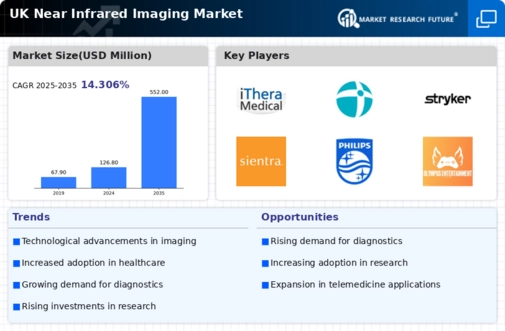Increased Research Funding
Research funding in the UK is playing a pivotal role in advancing the near infrared-imaging market. Government and private sector investments are increasingly directed towards innovative imaging technologies, which are essential for developing new applications in various fields, including medicine and agriculture. In recent years, funding for research in optical imaging technologies has surged, with allocations reaching upwards of £50 million annually. This financial support is crucial for fostering innovation and enhancing the capabilities of near infrared imaging systems. As research institutions collaborate with industry players, the near infrared-imaging market is expected to expand, leading to the introduction of cutting-edge solutions that address complex challenges in diagnostics and monitoring.
Expansion of Applications in Agriculture
The near infrared-imaging market is witnessing an expansion of applications in the agricultural sector, driven by the need for precision farming techniques. Farmers and agronomists are increasingly adopting near infrared imaging to monitor crop health, assess soil conditions, and optimize resource use. This technology enables the analysis of plant properties and soil composition, leading to improved yield and sustainability. In the UK, the agricultural sector is projected to invest significantly in near infrared imaging technologies, with market growth anticipated at around 6% over the next few years. This trend highlights the potential of near infrared imaging to enhance agricultural productivity while addressing environmental concerns.
Growing Demand for Non-Invasive Techniques
The near infrared-imaging market is experiencing a notable increase in demand for non-invasive diagnostic techniques. This trend is largely driven by the healthcare sector's shift towards patient-friendly procedures that minimize discomfort and risk. Non-invasive imaging methods, such as near infrared spectroscopy, are gaining traction due to their ability to provide real-time data without the need for invasive procedures. In the UK, the market for non-invasive imaging is projected to grow at a CAGR of approximately 8% over the next five years. This growth is indicative of a broader acceptance of advanced imaging technologies in clinical settings, which enhances diagnostic accuracy and patient outcomes. As healthcare providers seek to improve service delivery, the near infrared-imaging market is likely to benefit from this evolving landscape.
Rising Awareness of Early Disease Detection
The near infrared-imaging market is benefiting from a growing awareness of the importance of early disease detection among healthcare professionals and patients alike. This heightened awareness is driving the adoption of advanced imaging technologies that facilitate the early identification of conditions such as cancer and cardiovascular diseases. In the UK, initiatives aimed at educating both practitioners and the public about the advantages of early detection are gaining momentum. As a result, the demand for near infrared imaging solutions is likely to increase, with market analysts projecting a growth rate of around 7% over the next few years. This trend underscores the potential of near infrared imaging to play a critical role in preventive healthcare strategies.
Technological Integration in Medical Devices
The integration of near infrared imaging technology into medical devices is a significant driver for the near infrared-imaging market. As healthcare technology evolves, there is a growing trend towards incorporating advanced imaging capabilities into existing medical equipment. This integration enhances the functionality of devices such as endoscopes and surgical instruments, allowing for real-time imaging during procedures. In the UK, the market for medical devices featuring near infrared imaging is expected to witness substantial growth, with estimates suggesting an increase of approximately 10% in the next five years. This trend reflects the healthcare sector's commitment to improving surgical outcomes and patient safety through innovative imaging solutions.



















Leave a Comment